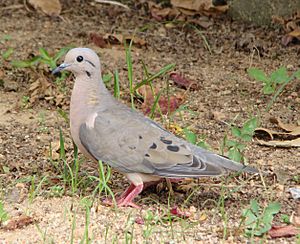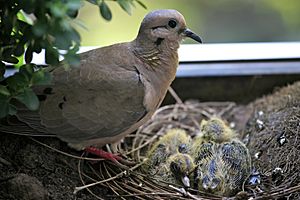Eared dove facts for kids
Quick facts for kids Eared Dove |
|
|---|---|
 |
|
| In Rio Grande do Sul, Brazil | |
| Scientific classification | |
| Kingdom: | |
| Phylum: | |
| Class: | |
| Order: | |
| Family: | |
| Genus: |
Zenaida
|
| Species: |
Z. auriculata
|
| Binomial name | |
| Zenaida auriculata (Marc Athanese Parfait Oeillet Des Murs, 1847)
|
|
The Eared Dove (scientific name: Zenaida auriculata) is a type of dove found in warm parts of the New World (North and South America). You can find it all over South America, from Colombia down to southern Argentina and Chile. It also lives on islands near the coast, like the Grenadines. Sometimes, these doves travel to different places, especially when they need to find more food. They build small nests out of sticks high up in trees to lay their eggs. It's a close cousin to the Mourning Dove found in North America.
Contents
What Does the Eared Dove Look Like?
The Eared Dove is about 24 cm (9.4 in) long. It has a long tail that looks like a wedge. This bird usually weighs around 112 g (4.0 oz). Adult male doves have mostly olive-brown feathers on their upper body. They also have black spots on their wings.
Head and Markings
The top of their head is grey. They have a black line right behind their eye. There's also a blue-black patch on their lower ear area. These black marks are why they are called "Eared Doves." Their belly feathers are a reddish-purple color. The tip of their tail is cinnamon-colored. The dove's beak is black, and its legs are dark red.
Female and Young Doves
Female Eared Doves are not as brightly colored as the males. Young doves are greyish-brown and look very plain. They have light stripes on their feathers. The sound these doves make is a deep, soft "oo-ah-oo."
Where Eared Doves Live and What They Eat
Eared Doves are very common in open areas like grasslands and farms. They are good at living near people. You can often see them on power lines and telephone poles near towns in Trinidad and Venezuela. They are also found in public places in big cities like Bogotá, Colombia. You might even see them eating near beach resorts in Tobago.
Food and Social Habits
These doves mostly eat seeds they find on the ground. But they will also eat other things, like soaked bread. Sometimes, they can become a problem for farmers because they eat crops. Eared Doves like to be with other doves when they are not eating. They form large groups, especially when they travel or gather to sleep.
Flight and Nests
Eared Doves fly high, fast, and straight. Their wings beat regularly, with an occasional sharp flick, which is typical for pigeons. During mating season, a male dove will fly steeply upwards and then glide in a half-circle back to where it started. They build a small nest out of sticks several meters high in a tree. The female lays two white eggs. The eggs hatch in 12 to 14 days. The young birds are ready to fly about 9 days after hatching. These doves can breed almost all year round if they have enough food and a good place to live.
Eared Dove Hunting
Eared Doves are hunted for sport in some parts of the world. There are many of these doves in the fields around Córdoba in northern Argentina. People estimate there are tens of millions of them there.
Population and Resilience
The number of doves hunted for sport reminds some people of how many passenger pigeons were hunted a long time ago. That hunting caused the passenger pigeon to disappear quickly. However, the Eared Dove seems to be much stronger. In fact, like the passenger pigeons once did, Eared Dove groups in Argentina and Bolivia can sometimes be so large they "darken the skies."
Hunting in Argentina and Bolivia
The Eared Dove populations in Argentina seem to be doing well. The birds breed four times a year. They thrive on the huge areas of grain, some grown just for them. Most of the grain is from commercial farms that are happy to support dove hunting. There are many special places for dove hunting, and the hunting season lasts all year. The Eared Doves around Córdoba do not travel far. The huge groups fly constantly between their sleeping woods and the open fields. In the Córdoba region of Argentina, these doves are called palomas doradas. This means "golden doves" because of the shiny feathers they sometimes have.
Further north, in Bolivia, near the Gran Chaco region, there are huge soy and sorghum farms. The dove hunting there is more seasonal, from May to September. Large groups of doves arrive from Argentina to eat the grain crops. Local people say that Eared Doves, which they call totaky', were rare just a few decades ago. This shows how strong the species is and how much the new large feeding areas have helped dove populations grow.
See also
 In Spanish: Zenaida para niños
In Spanish: Zenaida para niños


